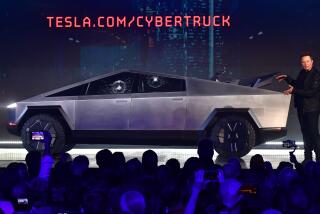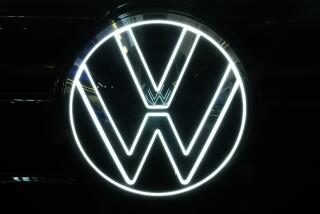Faulty air bags can spray shrapnel; carmakers issue recalls
For at least a decade, the owners of more than 3 million cars from six automakers drove around with air bags that could shoot shrapnel around the cabin in a crash.
The problem went undetected by the world’s biggest automakers and safety regulators on two continents until at least 2011, according to documents filed with the National Highway Traffic Safety Administration. Now those cars are being recalled.
“This clearly should have been caught earlier,” said Clarence Ditlow, executive director of the Center for Auto Safety. “This is a very serious defect, and it could kill you. The good news is that it doesn’t seem to happen very often.”
During all this time there appeared to be only six reported incidents on the road — four in the U.S. and two in Japan — and another six at Japanese salvage yards dismantling cars. There were no reported injuries.
The defect stems from faulty manufacturing in 2001 and 2002 by Takata Corp., a Japanese company that made the explosive wafers that power the lightning-quick inflation of air bags.
Honda, Nissan, Toyota, Mazda, and General Motors were all included in the recall, which affects cars produced from 2000 to 2004. BMW is also expected to issue a recall.
The problem results from faulty fabrication of the wafers at Takata factories in Moses Lake, Wash., and Monclova, Mexico. The problem can cause a metal canister in the air-bag system to explode, splattering metal shards into the passenger cabin. A similar defect in parts produced by Takata cropped up previously in driver’s side air bags and has killed several people.
Takata is the second-largest manufacturer of safety systems for cars globally, according to IHS Automotive. This is the biggest recall involving the company since 1995, when several automakers called back a record 9 million vehicles to replace faulty seat belts supplied by the company, said Paul Newton, an analyst with IHS Automotive.
Takata could not be reached for comment.
This latest recall comes amid a rash of recalls that some analysts say may be numbing consumers to serious safety issues.
“I am concerned that, within the flood of recalls, consumers won’t pay attention to the important ones,” said Michelle Krebs, an analyst with auto information company Edmunds.com. “This is an important issue. Consumers should get the repair made.”
The number of recalls issued by automakers in the U.S. has increased steadily over several decades, according to Edmunds.com. Back in the 1990s, the number of recalls ranged from 217 to about 444 a year. That increased to 514 to 781 in the next decade. In the last three years, it has ranged from 652 to 723.
The volume of cars recalled, however, is down from many prior years. Automakers recalled about 17.9 million vehicles last year, down sharply from 1999 to 2001, when annual volume ranged from 41 million to 58 million.
Because of the air-bag problem, Toyota Motor Corp. recalled 1.7 million vehicles, including about 510,000 in the U.S. The recalled vehicles include the Corolla and Matrix compact cars, the Sequoia SUV, Tundra truck and the Lexus SC 430, all manufactured from 2001 to 2003.
“The huge recall is expected to generate a good deal of unwelcome attention, particularly for Toyota as it strives to rebuild its reputation for quality in North America,” said Newton, the IHS Automotive analyst. He said Thursday’s recall is the fourth by Toyota since October to involve more than 1 million cars and the second this year after one in January
Honda recalled 1.1 million vehicles worldwide. The U.S. total includes 426,000 Civic sedans from the 2001 to 2003 model years, about 43,000 CR-V crossovers from 2002 and 2003 and about 92,000 Odyssey vans from 2002.
Nissan Motor Co. recalled about 480,000 Nissan and Infiniti vehicles worldwide. About 265,367 were sold in the U.S., all during the 2001 to 2003 model years. They include the Maxima and Sentra sedans and the Pathfinder SUV as well as the Infiniti I35 sedan and the Infiniti QX4 SUV.
General Motors Co. said it would recall about 55,000 Pontiac Vibes from the 2003 model year sold in the U.S. and Canada.
GM has discontinued the Pontiac line, so Vibe customers can get their cars fixed at other GM dealerships, said Alan Adler, a GM spokesman.
Mazda Motor Corp. said it recalled 20,000 vehicles, but fewer than 200 in the U.S. The affected cars include the Mazda6 and RX-8.
Takata said in NHTSA documents that it had also supplied the faulty part to BMW, but the German automaker said only that its engineers are looking into the issue. Ford Motor Co. and Chrysler Group both said they were not affected by the Takata air-bag problem.
Auto dealers will replace the faulty inflaters with new ones, Newton said. The companies didn’t say how much they would be spending to fix the recalled cars.
Ditlow, of the auto safety group, said automakers and safety regulators should have been tipped off to the air-bag issue much earlier, after a similar problem with driver’s-side air bags led Honda to recall 2.5 million cars in recent years.
In both cases, the wafers were improperly compressed during production by Takata. The wafers ignite in a crash, jetting hot gas through small holes in the metal canister to quickly inflate the air bag.
“It is designed to burn at a controlled rate, even at just a fraction of a second,” said Chris Martin, a Honda spokesman. “If the propellant burns too quickly, the little holes in the canister are not big enough to release all that pressure, and the canister can break apart.”
In some instances, the passenger air-bag malfunctions may also result from too much moisture getting into the wafers at Takata’s plant in Mexico, according to documents filed with NHTSA. The moisture would cause the wafers to expand, increasing the rate at which they burn.
Although NHTSA documents show the wafers were manufactured more than a decade ago, the problem first cropped up in an October 2011 crash of a Honda in Puerto Rico. Honda inspected the car the following February and realized that it was similar to what it had seen in driver’s side air bags. It asked NHTSA to look into the problem.
Over the next year, the agency and Honda found other unexploded canisters that had signs that “abnormal combustion was possible,” according to the documents. During the same period, Takata became aware of six incidents of canisters exploding in crashes, four in the U.S. and two in Japan. It also found that Japanese salvage yards, which take apart cars and set off the air bags as a safety precaution, have seen the problem in six autos.







